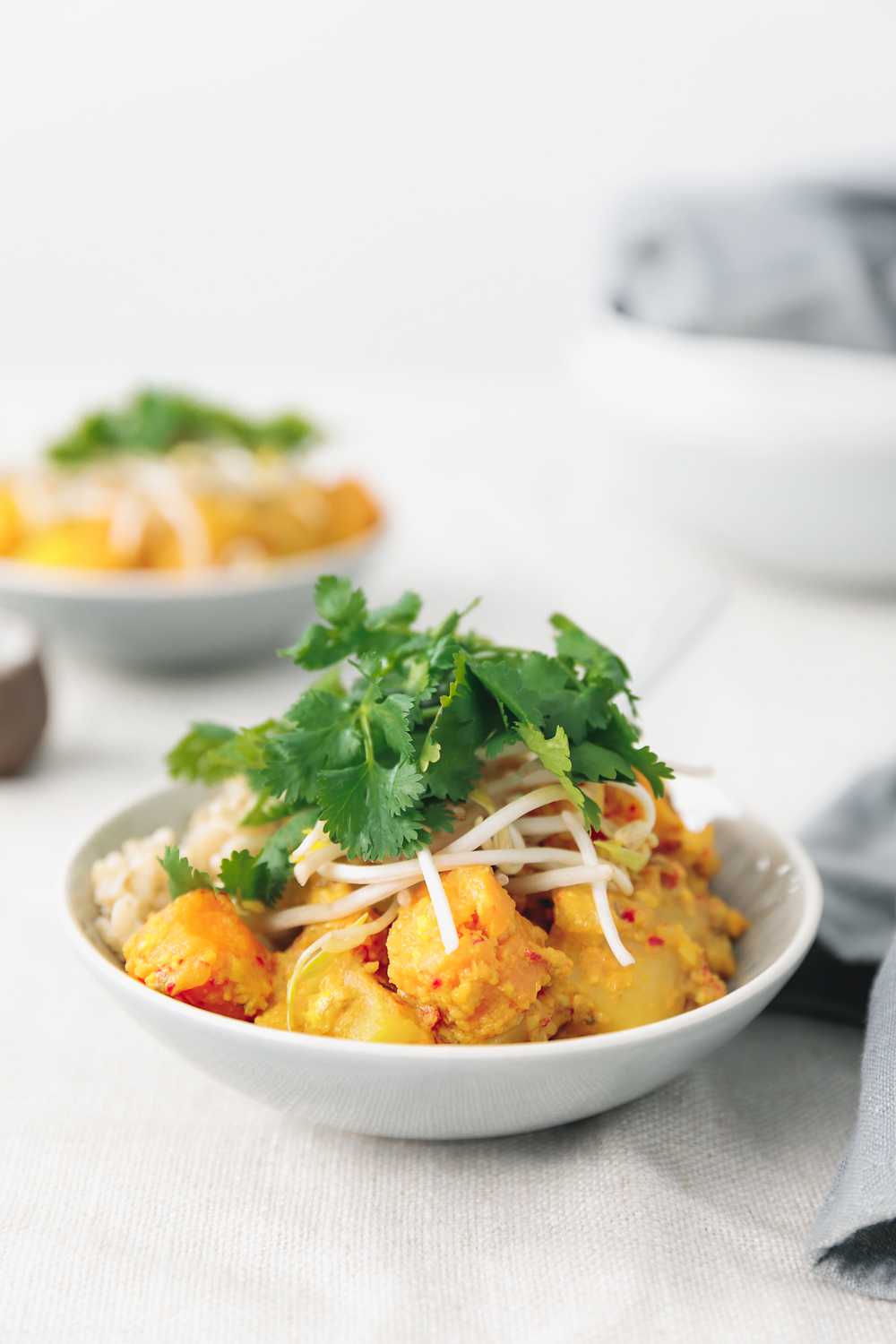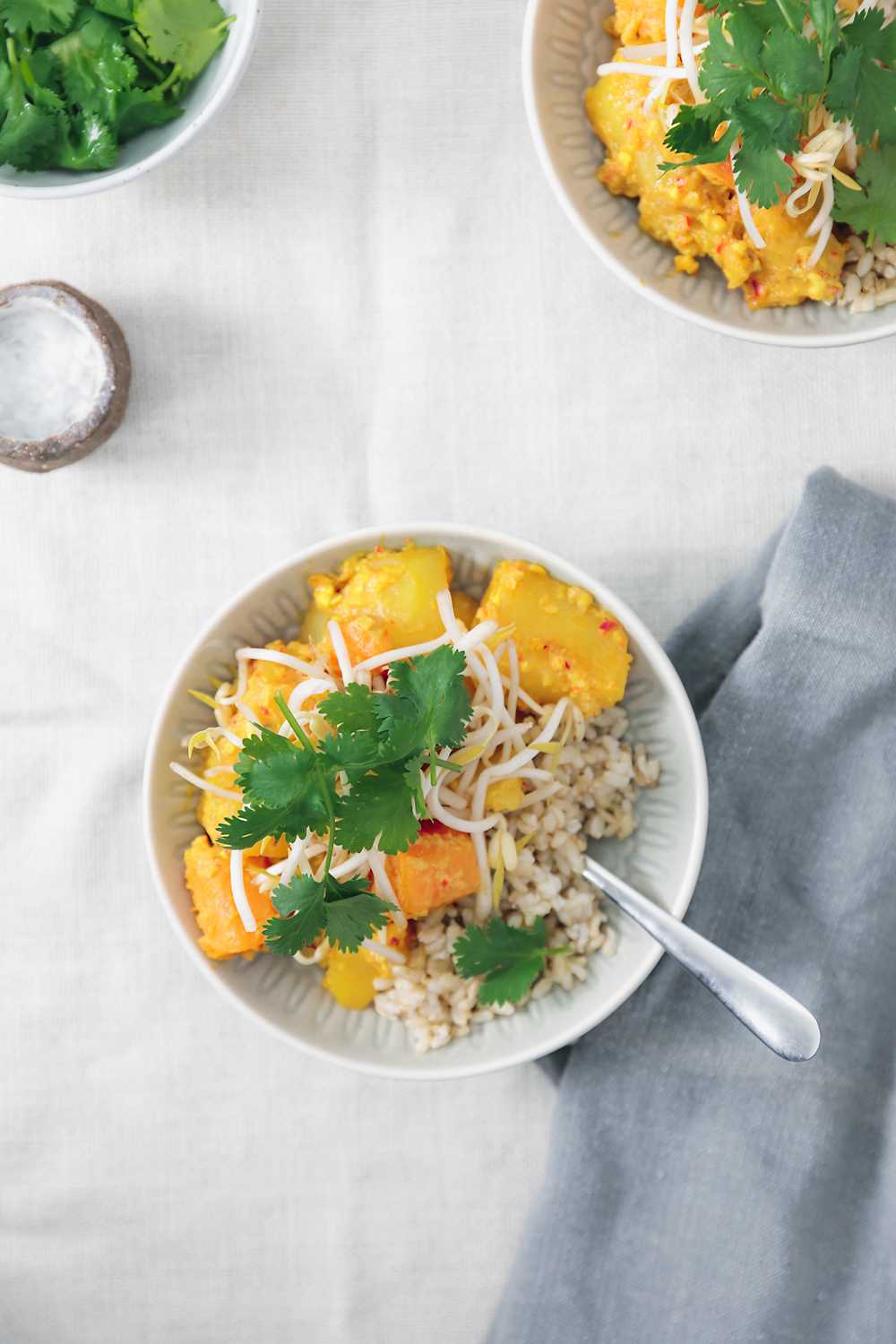This authentic vegetable curry recipe, Balinese Yellow Curry with Coconut Milk and Turmeric, recreates the scents, flavours and memories of Bali.

How do you remember your favourite holiday?
Through your photos or trinket souvenirs? For me, it’s through my stomach.
While travelling, I collect different teas, spices and candy to recreate the experience after I’ve returned home. My interest in history and its influence on food traditions, drives my passion to learn how to cook the meals I’ve enjoyed while I’m abroad. One of my favourite recipes that I learned was from my time in Bali.
Scents, flavours and memories come tumbling back to my mind with this authentic recipe: Vegetarian Balinese Yellow Curry with Coconut Milk and Turmeric. I’m not sure what brings me greater joy, the memory of learning how to make the dish, or the intoxicating flavours. Perhaps it’s a mixture of the two.
It was early in the morning. Perhaps not even 7:00a.m and beads of sweat developed on my forehead. I looked at the air vent of the bus in desperation, hoping cooler air would ease my discomfort. The bus was sun-bleached light blue, with rust developing on the roof like mould. The seats were faded orange plastic, cracked, and comfortable from years of wear. It was unlikely that the bus would have air conditioning. Frankly, I’m surprised that the bus was running at all. And yet, here we were roughly jerking around corners on the edge of a cliff. My mind flooded with catastrophising thoughts. “Bus crash in Bali – 7 tourists dead, one Australian.”
Occasionally, the bus would come to a screeching halt. Once to explore a local market with baskets overflowing with galangal, turmeric and chilli. Other times we stopped to view the tea terraces. Until at last, we arrived at an organic farm in the countryside of Ubud. I had booked myself an Authentic Balinese Cooking Class to explore the traditional agricultural and cooking techniques.
Our guide walked through the farm plots overflowing with fresh produce. Ginger, pineapples, onions, and ingredients I have never heard of let alone tasted. Plucking leaves from the surrounding trees and foraging for roots made me appreciate the Earth’s abundance. It’s incredible the different varieties of plants we can eat and yet we only cultivate 20 for 90% of our diet. What could we prepare if we had the knowledge?
When I finished foraging, chopping and cooking, we had the opportunity to taste our meals. Many were fresh and tangy, but my favourite was this Vegetarian Balinese Yellow Curry. The simple veggie curry was comforting but not too decadent. The turmeric was earthy, the carrots tender and sweet. And citrus characters from the lemongrass lightened the fattiness of the coconut creating balance. It was perfect.
I’ve created my own variation of the recipe with ingredients that are more accessible from your local market. This way you can enjoy a little Bali in your own kitchen! I hope you love it as much as I do! 🙂

Similar to many curries found in Asia, the flavours enjoyed in the Balinese curry is developed from the curry paste.
Balinese curry paste is traditionally prepared using a collection of Balinese herbs and spices such as kencur root, galangal, candlenuts, salam leaves and coconut milk. If these ingredients aren’t available to you, many variations exist by using more commonly found ingredients. Ginger can be used as an equivalent to kencur root, lemon zest instead of lemongrass and macadamia nuts as a replacement to candlenuts.
Although the paste can be used to make Balinese Chicken Curry, get creative with the ingredients to create delicious vegetarian variation. My favourite is Balinese Potato and Carrot Curry, or for a sweeter version, Balinese Pumpkin Curry using butternut squash!
The heart and soul of any Curry is the Curry Paste. Although it’s tempting to throw the ingredients into a food processor or blender, for a more authentic version filled with flavour, combine the paste ingredients together using a mortar and pestle. It extracts fuller flavour from the ingredients than a spinning blade, it creates brighter colours and a bolder taste!
Balinese Curry Accompaniments is where you can get creative with your curry and add a little bit of your own personal flair through different herbs and toppings! Some of our favourite accompaniments are fluffy jasmine rice, fresh coriander leaves, bean sprouts or a dollop of delicious sambal!





Balinese Yellow Vegetarian Curry with Coconut Milk
Ingredients:
Balinese Curry Paste (Yields 3)
- 8 large mild raw chilies washed
- 3 eschalots peeled
- 1 head of garlic peeled
- 1 thumb size galangal* peeled*
- 1 thumb size of ginger peeled
- 1/3 cup macadamia nuts
- 1 lemongrass stalk** outer leaves removed
- 1 tbsp ground coriander powder
- 1 tbsp ground turmeric powder
- 1/2 tsp ground pepper
- 1/2 cup water
Balinese Turmeric & Coconut Vegetable Curry
- 2 tbsp coconut oil
- 8 medium sized desiree potatoes peeled cut into 8 cubes
- 3 medium sized carrots peeled cut into large cubes
- 2 400ml cans coconut milk
- 1 tsp salt
To Serve
- bean sprouts washed
- brown rice soaked overnight and cooked as per packet instructions
- cilantro leaves washed
Instructions:
Balinese Curry Paste
- Place all of the ingredients into a food processor or blender, blend until well-combined.
- Once combined, separate the mixture into 3 portions. The Curry Paste recipe yields 3 meals and can be frozen / defrosted as required.
Balinese Turmeric & Coconut Vegetable Curry
- In a medium sized pot over a medium heat, warm the coconut oil. Place 1 portion of the Balinese Turmeric Curry Paste and stir for approximately 5 – 10 minutes or until fragrant.
- Stir in the potatoes and carrots until well-coated by the curry paste. Pour in the cans of coconut milk and salt, stir until well combined. You want to ensure the carrots and potatoes are submerged in milk, if not, add a splash of water.
- Bring the curry to the boil, reduce the heat and simmer uncovered for approximately 45 minutes, or until the root vegetables are cooked through.
- Serve on brown rice with fresh bean sprouts and cilantro leaves. Bon Appétit! ?
Notes:
Nutrition:
Disclosure:
Equipment: This recipe may contain links to products and equipment that I use and love myself. The links may contain affiliate links, meaning if you click the link and make a purchase, I may receive a small commission, at no additional cost to you.
Nutrition: The information shown is an estimate provided by an online nutrition calculator and does not include any other condiments or garnishes. Although Curated Life Studio attempts to provide accurate nutritional information, these figures should be considered as estimates and do not replace or substitute a professional nutritionist’s advice.
Loved This Recipe?
It would make my day if you left a comment below, or shared this post with your friends and family!
HAVE YOU PREPARED THIS RECIPE?
Let me know in the comments section below or by tagging #CuratedLifeKitchen on Instagram
Vegetarian Balinese Yellow Curry with Coconut Milk v.02 – August 2019
Balinese Turmeric & Coconut Curry v.01 – April 2018
Hey There, I’m Kylie. My passion is plant-based recipes and I want to help you create something gorgeous!
I believe in taking a slow approach to food – to eat locally, seasonally and consciously.
When I’m not taking photos, you can find me wandering the coastal paths of South-East Australia.
Bespoke Traveler says
I find it ever fascinating that travel can have us discovering such different lessons in the space of a day. Your balinese curry looks bright and beautiful, so I’m eager to try the handmade curry paste. Looking forward to your other experiences while traveling in Bali!
Kylie (Author) says
Thank you so much for your thoughtful comment Bespoke Traveler! I love the journey of travel and all the tiny lessons along the way!
I’ll put together a few posts with my notes and experiences of Bali. ❤️
Czjai says
We’re huge fans of curry, but I haven’t tried preparing it with just vegetables.
I’m not sure what galangal is called here in the Philippines, I will have to check it out. 🙂
Renuka says
I am from kerala state,India.this curry sounds our vegetable stew,goes with anything.But i don’t know
what is galangal,i know it is in ginger family.
i searched and i found one similar root like gonger
but we don’t use that in cooking.It is an
ayutvedic medicine.Without galagal
we can make this yellow curry.Thank you for the recipe..i am a fan of your shows.